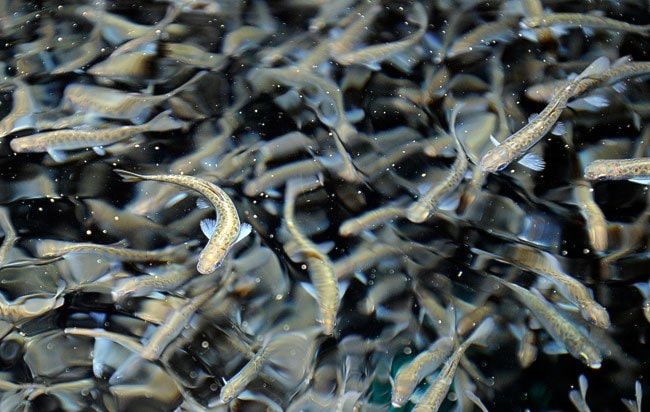Phyllis Nelson is a master fish tagger.
At the Whitehorse Rapids Fish Hatchery this week, she is performing micro-surgery on more than 10,000 tiny chinook salmon fry every day.
The Vancouver resident travels all over Western Canada every spring to help hatcheries tag their fish.
Here in the Yukon, Nelson’s team will clip and tag 150,000 fish over about 10 days. She has worked with the hatchery for more than 30 years.
“It would take a lot longer if we didn’t have Phyllis,” said Lawrence Vano, the hatchery’s manager.
“She’s super, super quick, and she’s very diligent about her work.”
The goal of the procedure is to implant a piece of wire into the nose of each fish before it is released to the wild.
The wire is a millimetre long and barely visible on a fingertip. But a microscope would reveal a series of numbers printed on its surface.
In addition to the wire implant, the top adipose fin is clipped from each fish, signalling that it was born in a hatchery.
If a hatchery-born chinook is caught out in the ocean, or later on its way back up the Yukon River, the wire could be retrieved and the fish traced back to the hatchery and year of its release.
Nelson directs a crew of about six working together to get this year’s stock clipped and tagged as quickly as possible.
Fry are removed from their tanks in small batches and immersed in a tranquilizer solution.
From there they are moved to a shallow pool, where workers handle them one by one and delicately snip their tiny adipose fin with scissors.
Then they are placed in a gently-sloped fry-sized water slide, which takes them down to the tagging station.
That’s where Nelson takes the fish one by one, gently presses on each head to open the mouth, places the mouth around a mould designed to hold the fish in place, and presses the button that triggers the hypodermic needle that inserts the piece of wire.
The fish then travel down a second tube, and a powerful metal detector separates out the fish that have been tagged correctly from those that have not.
Those that end up in the reject bucket will be re-tagged at the end of the day.
It’s repetitive work, with hands immersed in six-degree-Celsius water for long hours.
But Nelson takes great care to ensure that the tiny fry are properly handled at each step along the way.
“If you don’t do a very good job, you can kill the fish really easily or you can stress them out,” she said.
“This is really important. That’s why I’m really on top of everybody, making sure that all the jobs are done well.”
Raising chinook salmon is not cheap.
Each of the two tagging machines at the hatchery cost $30,000 to $40,000, said Nelson.
A roll of the coded wire - which will tag 10,000 fish - runs $1,000.
But the work that Nelson and her staff do helps to ensure the survival of a chinook salmon run that has dwindled in recent years.
Salmon that come from above the Whitehorse dam have a particularly tough journey. They migrate further than any of the other Yukon River chinook, travelling 3,200 kilometres to their natal streams.
Adults must contend with the fish ladder on their way upriver, and juveniles must survive the turbines on their way down to the ocean.
It is estimated that 30 per cent of juveniles reared above the dam are killed on their way through. The primary objective of the hatchery is to replace that lost stock, said Vano.
And although numbers of fish coming up through the fish ladder have been low over the last couple of years, management decisions on lower parts of the river have started to show positive effects, he said.
“The quality of the fish and the ratio of male to female is bang on, and the hatchery contribution is bang on,” said Vano. “With our genetic stock that came this far, I’m super happy with the condition of these fish.”
The public was invited out to help release 10,000 of the fry into Wolf Creek last Sunday.
The rest will be released by helicopter into Michie Creek, McClintock Creek, and the Yukon River main stem near Wolf Creek.
Their chances of survival are not high. Of about 750 smolts that head out for the ocean, only about two to six adults are expected to return to their natal streams.
It’s hard to say which of Nelson’s carefully tagged fish will make it back to Whitehorse in three, four or five years.
But when they do, they will go back to the place where they were released and leave thousands of eggs - wild, native fish eggs that will begin their journey without the protective care of the fish hatchery.
Contact Jacqueline Ronson at
jronson@yukon-news.com
